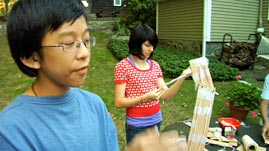Teachers' Domain - Digital Media for the Classroom and Professional Development
User: Preview


Source: Mission: Solar System/DESIGN SQUAD NATION
Robotic arms are cool, useful, and fun to make. In this video from Design Squad Nation, kids design and build controllable mechanical arms and use their “robo” arms to lift objects and to play a series of games. As they build their mechanical arms, the kids use the engineering design process, apply a variety of science concepts (e.g., levers and tension and compression), and learn how NASA uses robotic arms in many of its missions.
Robo Arm Challenge—Leader's Notes and Kid's Handout (Document)
Sandeep Yayathi: Robotics Engineer (Video)
Mission: Solar System Teacher's Guide (Document)
Mission: Solar System Training Video (Video)
Teacher's Guide
Check out the Mission: Solar System—Teacher's Guide (PDF)! It gives you an overview of the project’s four components and how to use them to run a challenge—start to finish. In addition, there are resource pages that offer tips for implementing Mission: Solar System’s challenges. For example, there are ideas for how to help kids use the design process and suggestions for effective ways to talk to kids about engineering. You’ll also find related online resources from NASA and Design Squad, education standards, and professional-development resources.
Videos
 Loading Standards
Loading Standards